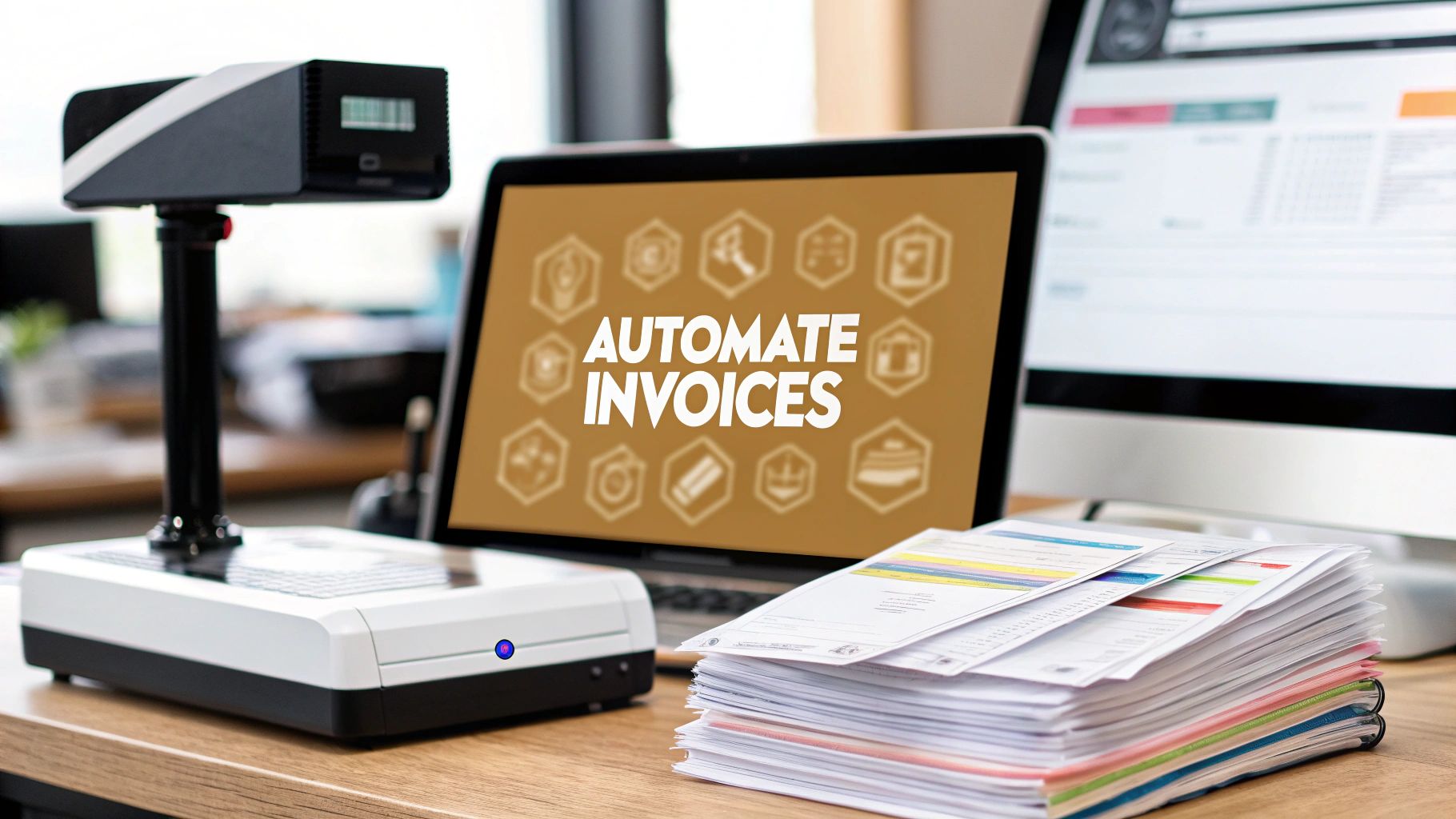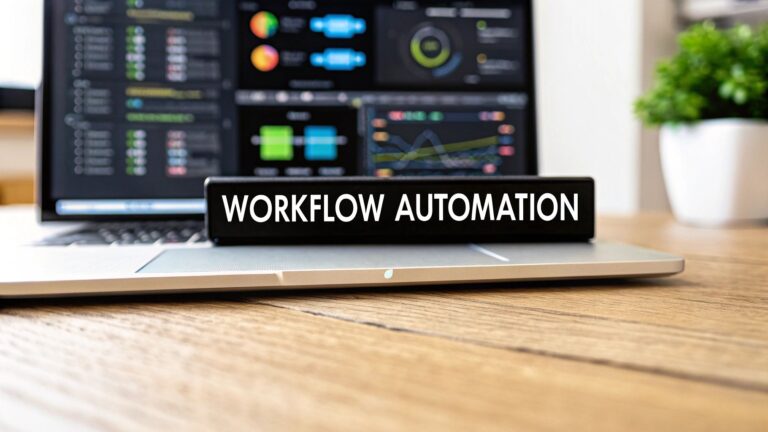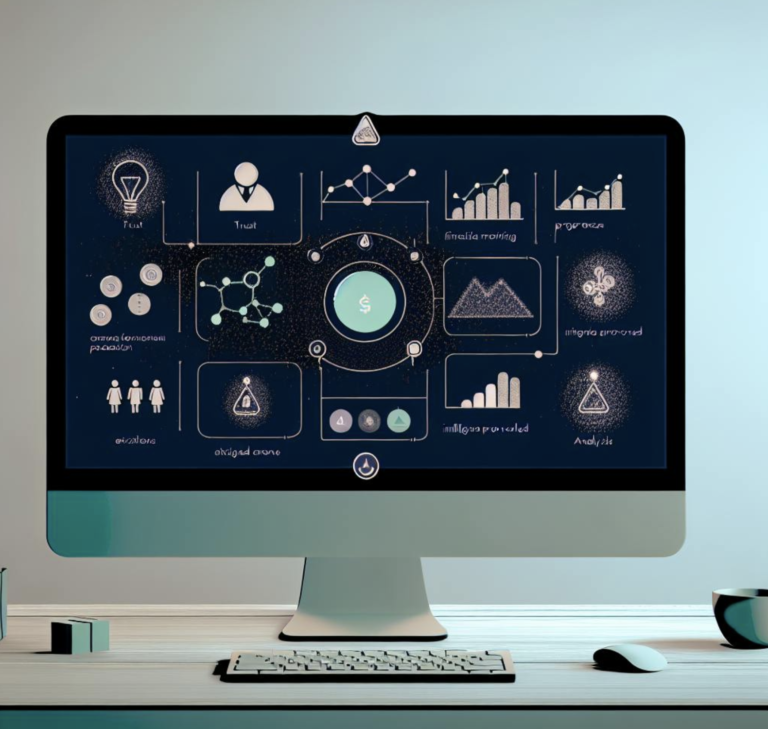How to Automate Invoice Processing: A Complete Guide
So, you’re thinking about automating your invoice processing. What we’re really talking about here is using smart software to grab invoice data, check it for accuracy, and get it approved—all with way less hands-on effort from your team. It’s about ditching the mind-numbing data entry and endless email threads for a system that just works.
The True Cost of Manual Invoice Processing
Before we jump into the "how," let's get real about the "why." Sticking with manual invoice processing isn't just slow—it's a silent killer for your company's bottom line. These inefficiencies are sneaky, often hiding in plain sight as just another "cost of doing business."
But the costs go far beyond an employee's hourly rate. Think about all the time wasted chasing down approvals, fixing typos from manual data entry, or paying late fees because an invoice got lost in someone's inbox. Every single time a person has to touch an invoice, it’s a new chance for something to go wrong.
How Those "Little" Inefficiencies Snowball
Let's imagine a typical B2B SaaS company that processes around 1,000 invoices every month. One invoice gets misplaced, and you miss out on an early payment discount. Seems minor, right? But when that happens over and over, the lost savings really start to stack up. Now, add in the hours your finance team spends hunting down that missing document, and the true cost starts to become painfully clear.
The real problem with manual processing isn't a single big mistake; it's death by a thousand cuts. It’s all the small, repetitive tasks—fixing data, paying late fees, and losing discounts—that quietly drain your resources over time.
This is how tiny issues compound into massive headaches. A simple data entry error could lead to an overpayment that takes hours of work to reconcile. An invoice sitting in the wrong manager's inbox for a week can strain a crucial vendor relationship. These aren't just administrative annoyances; they're direct hits to your financial stability.
The Hidden Financial Drain
The numbers don't lie. Industry research consistently shows that the average cost to manually process a single invoice can be as high as $22.75. That figure isn’t just salary—it’s packed with the hidden costs of verification, back-and-forth communication, and fixing mistakes. You can dig deeper into these global AI invoicing trends to see the full impact.
For that company we mentioned handling 1,000 invoices a month, we’re talking about a potential cost of over $270,000 a year. Let that sink in. A quarter of a million dollars, just to pay the bills.
When you look at it that way, the case for automation becomes a no-brainer. You're not just buying another piece of software; you're fundamentally changing your accounts payable department from a reactive cost center into a smart, strategic asset for the business.
Map Your Current Invoice Workflow to Pinpoint Bottlenecks
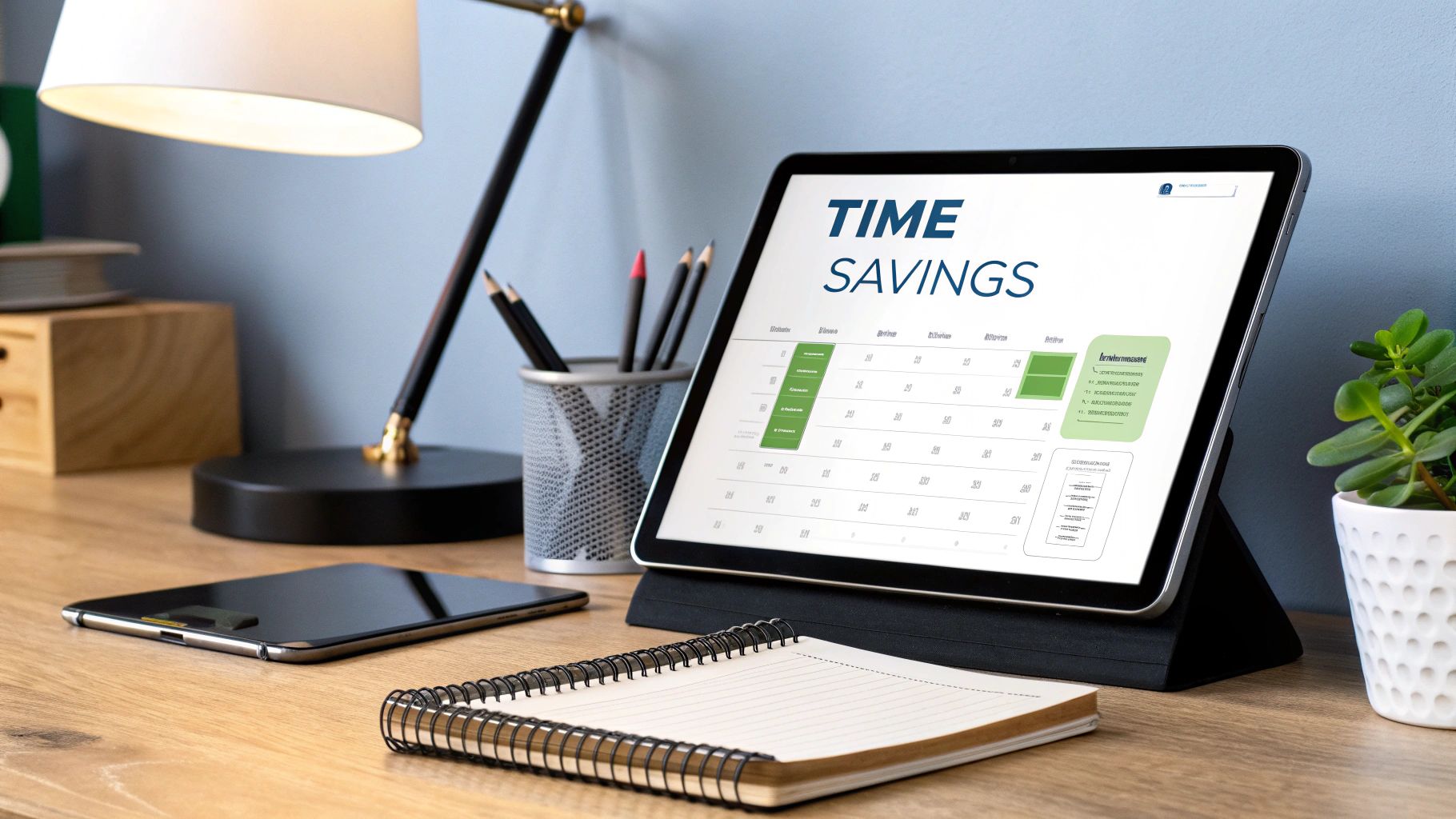
Before you jump into any new automation tool, you have to get painfully honest about how things work right now. Trying to automate a process you don't fully understand is like trying to navigate a new city without a map—you’ll just end up going in circles.
The first real step is to create a detailed blueprint of your invoice’s entire journey, from the moment it hits your company to the second the payment is confirmed. This process will uncover every touchpoint, every manual handoff, and—most importantly—every frustrating delay. You can't fix what you can't see.
Trace Every Step and Identify Who's Involved
Get granular here. Follow an invoice as if you were a detective tracking a lead. The more detail you capture, the more opportunities for improvement you'll find.
Start by asking the tough questions:
- How do we get invoices? Are they landing in a shared inbox, being uploaded to a portal, or—dare I say it—still arriving as paper mail?
- Who sees it first? Is it an admin, someone in accounts payable, or the department manager who requested the service?
- Then what happens? Document every single action. Think about the manual data entry into a spreadsheet, checking it against a PO, or forwarding it for approval.
- Who has to sign off? Make a list of every person who might need to approve an invoice and why (e.g., project managers for specific costs, department heads for anything over $1,000).
This exercise is often a real eye-opener. I’ve seen teams discover invoices languishing in unmonitored inboxes for days or realize a single manager is the approval bottleneck for three separate departments.
Visualize the Process to See Where Time Is Lost
Once you have a list of all the steps and people involved, it’s time to draw it out. A simple flowchart works wonders. You don't need fancy software; a whiteboard and a marker will do the trick. Each box is an action, and each arrow shows where the invoice goes next.
As you build this visual map, start adding time estimates to each step. How long does an invoice sit in the AP inbox before it’s even opened? What’s the average wait time for a manager's approval? This simple addition turns your diagram into a powerful diagnostic tool.
The most impactful insight you'll gain from workflow mapping isn't just seeing the steps; it's seeing the time between the steps. Those gaps are where efficiency—and money—vanishes.
This isn't just a hunch; the industry is moving away from these manual black holes. In 2023, about 85% of invoices were still keyed in by hand. By 2024, that number dropped to around 60% as more companies finally pinpointed these slowdowns and invested in automation. If you're curious, you can dig into more key automation statistics to see the broader trend.
This data-driven approach shows you exactly where the process breaks. You might discover that 30% of your total processing time is just spent waiting for a single signature. That’s your red flag. It tells you that your approval routing is the first and most critical area to automate for a quick, high-impact win.
Choosing the Right Invoice Automation Technology
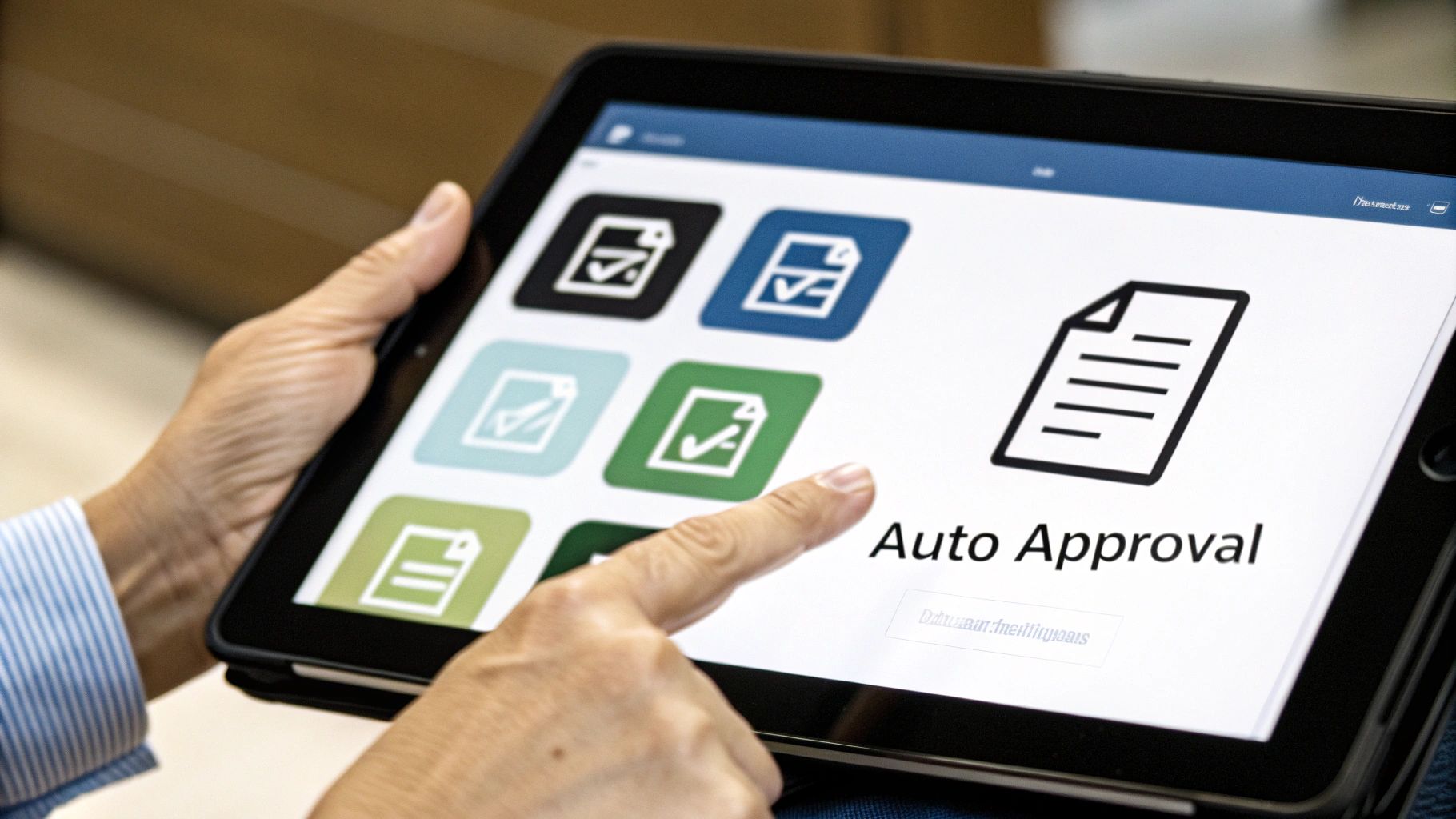
Diving into the market for automation tools can feel overwhelming. There are so many options, each with a long list of features. My advice? Don't get bogged down in the marketing hype. Instead, focus on the core technology that makes these systems tick. When you understand the engine, you can pick the right vehicle for your company’s specific needs.
At the heart of any modern invoice automation system, you’ll find three key pillars: Optical Character Recognition (OCR), Artificial Intelligence (AI) and Machine Learning (ML), and seamless integrations. Each piece of the puzzle plays a critical role in turning a static invoice document into clean, actionable data that flows right into your financial systems.
Think of it as a three-stage assembly line. OCR is the first stop, where the raw material—the invoice—gets digitized. Next, AI acts as the intelligent quality control, making sense of that data. Finally, integrations are the delivery mechanism, getting the finished product exactly where it needs to go.
The Building Blocks of Smart Automation
Understanding how these technologies work together is the secret to making a smart investment. A basic tool might only offer one of these components, but a truly powerful platform will combine all three for a genuinely hands-off experience.
-
Optical Character Recognition (OCR): This is the baseline technology. It takes a PDF or a scanned paper invoice and turns the pictures of letters and numbers into actual text your computer can read. It’s a necessary first step, but on its own, it’s just a jumble of data without any real context.
-
AI and Machine Learning (ML): This is where the magic happens. AI doesn't just read the text; it understands it. It knows that "INV-123" is the invoice number and "$540.00" is the total due, even if they’re in completely different spots on invoices from different suppliers. This layer is what validates the information and, crucially, gets smarter over time.
This combination of technologies has come a long way. Today's best systems, which blend AI, ML, and advanced OCR, can hit data extraction accuracy rates of over 90%. They’ll automatically grab everything from invoice numbers to vendor names and even individual line items, no matter how chaotic the document layout is.
Comparison of Invoice Automation Tool Types
To help you navigate the landscape, it's useful to group the available tools into a few main categories. The table below breaks down the different types of solutions you'll find, what they do best, and who they're for.
| Tool Type | Key Features | Best For | Pricing Model |
|---|---|---|---|
| Standalone OCR Tools | Basic data extraction from scanned documents or PDFs. Outputs to formats like CSV or XML. | Low-volume businesses or anyone just starting to move away from paper-based processes. | Pay-per-page or a low monthly subscription based on document count. |
| Integrated AP Platforms | End-to-end management, including data capture, 3-way matching, approval workflows, and direct sync with ERPs. | Mid-sized to large companies that need a complete solution to manage the entire AP lifecycle. | Per-user monthly fees, tiered pricing based on invoice volume, or a hybrid model. |
| Integration Platforms | Connectors that link your existing apps (e.g., email to accounting software) to build custom automation rules. | Tech-savvy teams who want to create a bespoke workflow using the software they already own. | Subscription-based, often priced by the number of automated tasks or "zaps" run per month. |
Looking at this, it becomes clear that not all automation tools are created equal. Your choice will really depend on your company’s size, how many invoices you process, and what software you're already using. Some businesses just need a simple tool to get invoices digitized, while others are looking for a comprehensive accounts payable platform that handles everything. To go deeper, you can learn more about what Intelligent Document Processing is in our detailed guide.
The best technology isn’t the one with the most features; it’s the one that integrates most smoothly into your existing workflow and scales with your business needs. Don't pay for an enterprise-level system if a targeted, integration-focused tool will solve your primary bottleneck.
Ultimately, picking the right tech comes back to the workflow map you created earlier. A standalone OCR tool might be a solid first step, but a fully integrated AP platform is what really unlocks the strategic value of a truly automated finance function.
Designing Your Automated Invoice Processing Workflow
Alright, you’ve mapped your current process and picked your tech. Now for the fun part: actually building your new, automated system. This is where you take your blueprint and turn it into a smart, self-running workflow. The whole point is to create a set of rules that can handle invoices from the moment they arrive to the final approval, all with minimal human touch.
Think of it like teaching your accounts payable system how to think. Instead of a person manually deciding what to do with an invoice, the system will now make those decisions instantly and with far greater accuracy.
This visual gives you a great high-level look at how an invoice moves through an automated system—from capture and validation all the way to the approval workflow.
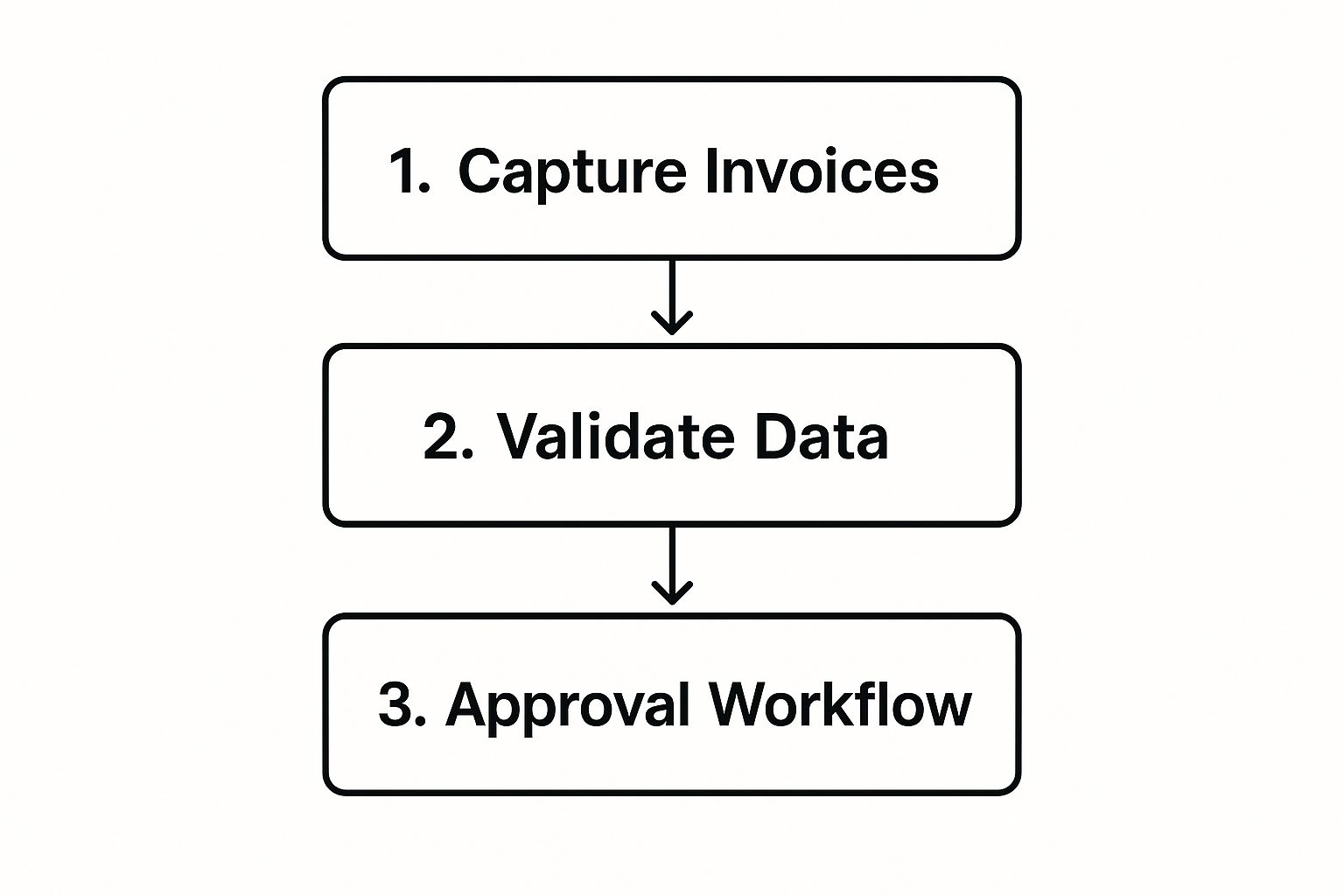
Each of these stages is a critical checkpoint where you can embed your business logic to keep things accurate and moving quickly.
Configure Smart Data Capture
First things first, you need to tell your system where to find the invoices. The beauty of modern platforms is that they can watch multiple places at once, funneling every incoming bill into a single, organized pipeline.
You'll want to set up capture points for all your main channels:
- Dedicated AP Inbox: This is a classic. Set up an email address like
invoices@yourcompany.comand configure your system to automatically grab and process any attachment that lands there. - Vendor Portals: If you work with suppliers who use their own portals, you can often use API connectors or browser automation to pull new invoices as soon as they're available.
- Scanned Documents: For the few paper invoices still floating around, a simple scan-to-folder setup works wonders. The system just watches a network folder and processes anything new that appears.
This multi-channel approach is key. It ensures no invoice falls through the cracks, gets lost in a personal inbox, or sits on someone's desk for a week. It's a foundational step for building a system that can handle growth without you needing to hire more people. To see how far we've come from older methods, it's worth understanding what Robotic Process Automation is and how it functions.
Establish Robust Validation Rules
Once an invoice is captured, it has to be checked. This is where automation really flexes its muscles, catching tiny errors that even a detail-oriented person might miss after a long day. You're essentially building a digital gatekeeper to make sure only clean, correct data gets through.
The most powerful rule you can implement is 3-way matching. The system will automatically compare the invoice against its corresponding purchase order (PO) and the goods receipt note.
- If all the details—like quantity and price—match across the invoice, PO, and receipt, it gets an immediate green light.
- But if there’s a mismatch, like the invoiced amount being higher than what was on the PO, the system flags it instantly for a human to review.
I can't stress this enough: setting up 3-way matching is one of the single best ways to stop overpayments and fight invoice fraud. It completely changes the game for your team, moving them from mind-numbing manual checks to only investigating the exceptions that actually need their expertise.
You can add other rules, too. For instance, automatically flag any duplicate invoice numbers or reject invoices that are missing a required PO number. This kind of proactive error-checking will save you from countless hours of painful reconciliation work down the road.
Design Dynamic Approval Routes
Finally, it's time to map out who approves what. Manually forwarding invoices for approval is a massive bottleneck in most companies. With automation, you can build dynamic routes based on whatever criteria make sense for your business.
Here are a few practical examples I’ve seen work really well:
- By Amount: Any invoice under $500 is automatically approved for payment. Those between $501 and $5,000 route to the department manager. Anything over $5,000 needs a second look from the Head of Finance.
- By Department: Invoices coded to Marketing go straight to the CMO. IT expenses? They land on the CTO’s desk. Simple.
- By Vendor: For recurring bills from trusted suppliers, like your cloud hosting provider, you can set them to auto-approve as long as the amount is within an expected range.
These rules take all the guesswork out of the process. Every invoice lands exactly where it needs to go, instantly. This step alone can shrink your approval timelines from weeks to mere hours, which not only makes your vendors happier but also puts you in a great position to snag those early payment discounts.
Weaving Automation into Your Financial Systems
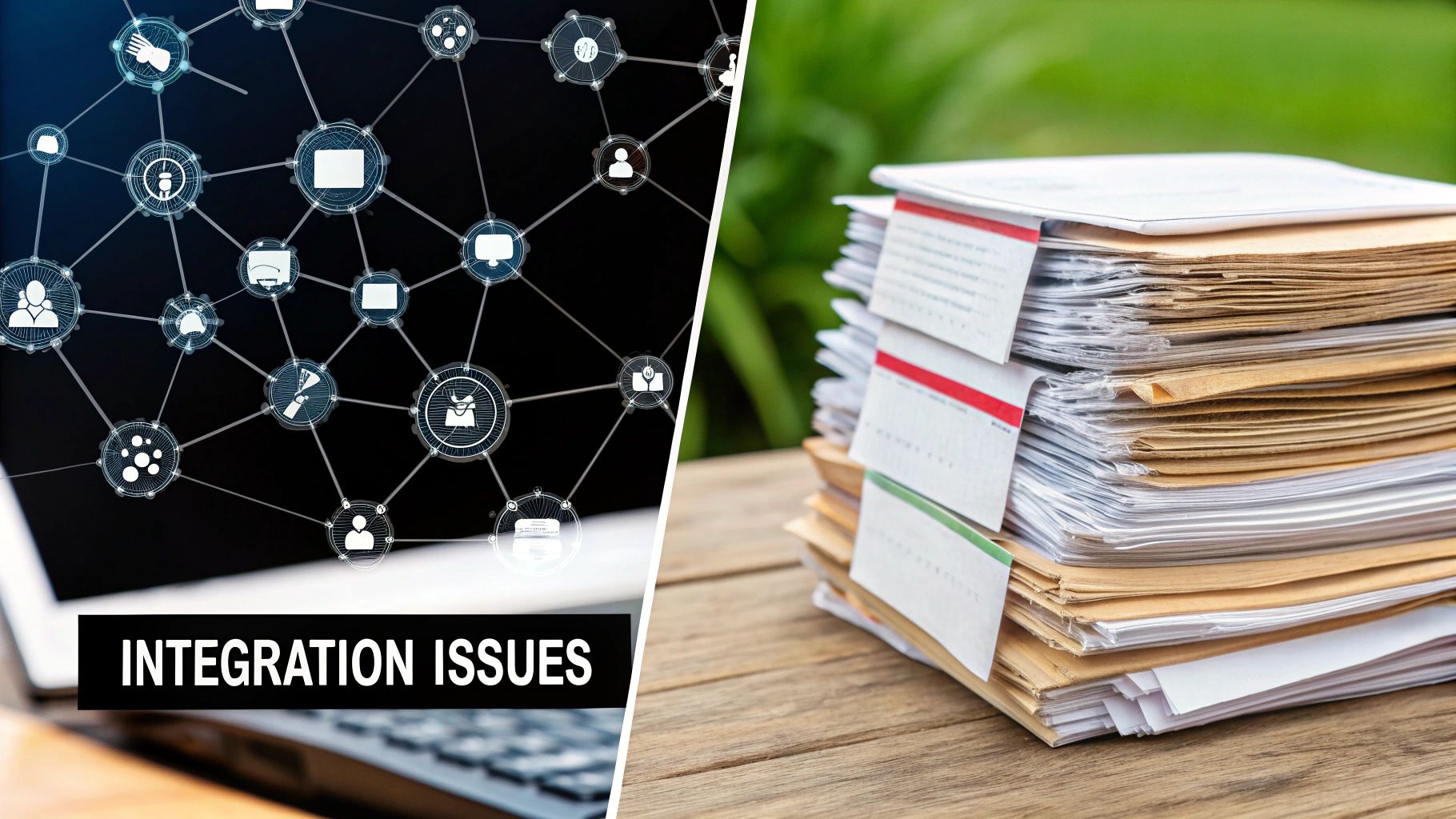
Let's be honest: an invoice automation tool that doesn't talk to your other financial software is basically just a fancy, high-speed data entry problem. You’ve just moved the bottleneck, not eliminated it. The real magic happens when your new system can communicate seamlessly with your core accounting or ERP platform.
This connection is what turns a simple tool into the central nervous system for your entire accounts payable process.
The whole point is to create a reliable, two-way data highway. When an invoice gets the green light in your automation platform, all the critical details—vendor info, GL codes, payment terms—should pop up in your accounting system instantly. No one should ever have to copy and paste that data again.
This sync is the final piece of the puzzle for achieving true "touchless" processing, where an invoice can travel from a vendor's outbox to being ready for payment without a single person having to intervene. It’s the difference between doing half the job and truly automating the work.
How to Connect Your Systems
Getting your platforms to talk to each other isn't a one-size-fits-all deal. How you'll do it depends entirely on your existing tech stack, like whether you're running on QuickBooks or NetSuite, and the automation platform you've chosen. Generally, you’ll run into a couple of common methods.
- Native Connectors: This is the dream scenario. Most modern AP automation platforms come with pre-built, plug-and-play integrations for popular accounting software. It’s often as simple as entering your login details and authorizing the connection.
- API Integration: For more specialized or homegrown systems, an Application Programming Interface (API) is your best friend. This route gives your developers the power to build a custom bridge between the two systems, creating a perfect data flow that fits your unique operational needs.
For example, a native connector might sync all the standard invoice data perfectly. But with an API, you could get more granular, like updating custom fields in your ERP or triggering specific follow-up workflows based on the invoice type.
The absolute gold standard for any integration is establishing a single source of truth. Your ERP or accounting software must remain the definitive financial record. Your automation tool's job is to feed it clean, validated data—never to conflict with it.
Keeping Your Financial Data Pristine
A botched integration is a fast track to chaos. Think mismatched vendor records, incorrect GL codes, and duplicate entries—the kind of mess that gives finance teams nightmares during reconciliation. To sidestep this disaster, you need a solid game plan before you connect anything.
Here's a quick checklist I always follow to make sure an integration goes smoothly:
- Map Your Data Fields: Before flipping any switches, get granular. Create a map that shows exactly where data goes. Does the "Vendor Name" field in the AP tool line up with the "Supplier" field in the ERP? Do this for every single data point, from invoice numbers to line-item descriptions.
- Set Clear Sync Rules: Decide on the timing and triggers for data movement. Do you need a real-time sync every time an invoice is approved? Or is a batch update at the end of each day a better fit for your workflow?
- Test, Test, and Test Again: Never, ever test an integration with your live financial data. Use a sandbox or a dedicated test account. Run dozens of different invoice scenarios through the entire workflow and meticulously check that everything lands correctly on the other side.
Getting this part right is non-negotiable. A clean, reliable integration ensures your financial records stay accurate, turning your automated invoicing system into an indispensable part of your financial operations.
So, you’ve built your automated invoice workflow. That’s a huge step, but the work isn’t quite done yet. Setting up the system is really just the starting line; the real gains come from what you do next.
Think of it this way: simply flipping the switch on your new system doesn't guarantee you're getting the most out of it. To prove its value and find opportunities to make things even smoother, you have to keep an eye on performance.
This means you need to get comfortable with the data. Your automation platform is more than just a workflow engine—it's a goldmine of insights that gives you a crystal-clear, unbiased picture of how your AP process is really doing.
What to Measure: Your Key Performance Indicators
To get a real handle on performance, you don't need to track dozens of different things. Start with a few high-impact metrics that tell you the most important parts of the story.
These three KPIs will give you a powerful snapshot:
- Invoice Processing Time: How long does it take, on average, from the moment an invoice lands in your inbox to when it's fully approved? This is your most direct measure of speed and efficiency.
- Cost-Per-Invoice: This one is simple but powerful. Divide your total AP department costs (think salaries, software, etc.) by the number of invoices you process. Your goal is to see this number consistently trending downward.
- Early Payment Discount Capture Rate: Are you taking advantage of the discounts your vendors offer? This metric tracks the percentage of available discounts you actually claim, turning your AP team from a cost center into a real profit generator.
Keeping tabs on these figures gives you the hard evidence you need to show stakeholders the tangible ROI of your automation project. If you want to explore this further, our guide explains more about how to measure business growth with the right data.
One of the biggest mistakes I see is treating automation as a "set it and forget it" tool. The teams that see the best results are the ones who are constantly looking at their performance data and aren't afraid to tweak their workflows based on what it's telling them.
Let’s say you notice that invoices from the marketing department are always getting stuck in the approval stage. That's a red flag. Digging into the data might reveal a bottleneck. It could be something as simple as an incorrect routing rule or a manager who needs a quick training refresher on the new system.
It’s these small, data-driven adjustments that turn a good automated process into a great one. This is how you ensure your system keeps delivering value long after the initial setup is complete.
Got Questions About Invoice Automation? We've Got Answers
Stepping into automated invoice processing always brings up a few questions. It's a big change, after all. Here are some of the most common things people ask when they're getting started.
How Long Does It Take to Get an Automated System Running?
This really depends on the complexity of your setup. If you're a smaller business using a straightforward, cloud-based tool, you could be up and running in just a few days.
For a larger company with a custom ERP system and tangled approval chains, you're probably looking at a few weeks to get everything integrated and running smoothly.
A few things will speed up or slow down your timeline:
- How complex your internal approval workflows are.
- The variety of invoice formats you receive from vendors.
- How clean and organized your current vendor data is.
How Accurate Is the AI at Pulling Data from Invoices?
Honestly, it's incredibly accurate. Modern AI and OCR tools consistently hit data extraction accuracy rates of 90% and often push past 95% for standard invoice formats.
The best part? It gets smarter over time. The machine learning algorithms learn your specific vendor layouts and coding preferences with every invoice they process, constantly improving their accuracy.
Think about what 95% accuracy really means. For every 100 invoices, 95 are processed with little to no human touch. This frees up your finance team to focus on high-value work instead of mind-numbing data entry.
What About Old-School Paper Invoices? Can I Automate Those?
Absolutely. Any solid automation system is built to handle invoices no matter how they arrive—digitally or physically.
The process is simple: you just scan the paper invoices to create a digital file, like a PDF. From that point on, the AI and OCR technology kicks in and extracts the data just like it would from an email attachment.
And as you dive deeper into financial automation, it's helpful to understand related concepts, like what a chargeback means in accounting, to get a full picture of your financial health.
Ready to stop wasting time on manual work and start scaling? The team at MakeAutomation builds powerful, AI-driven automation systems designed to boost your ROI. https://makeautomation.co

